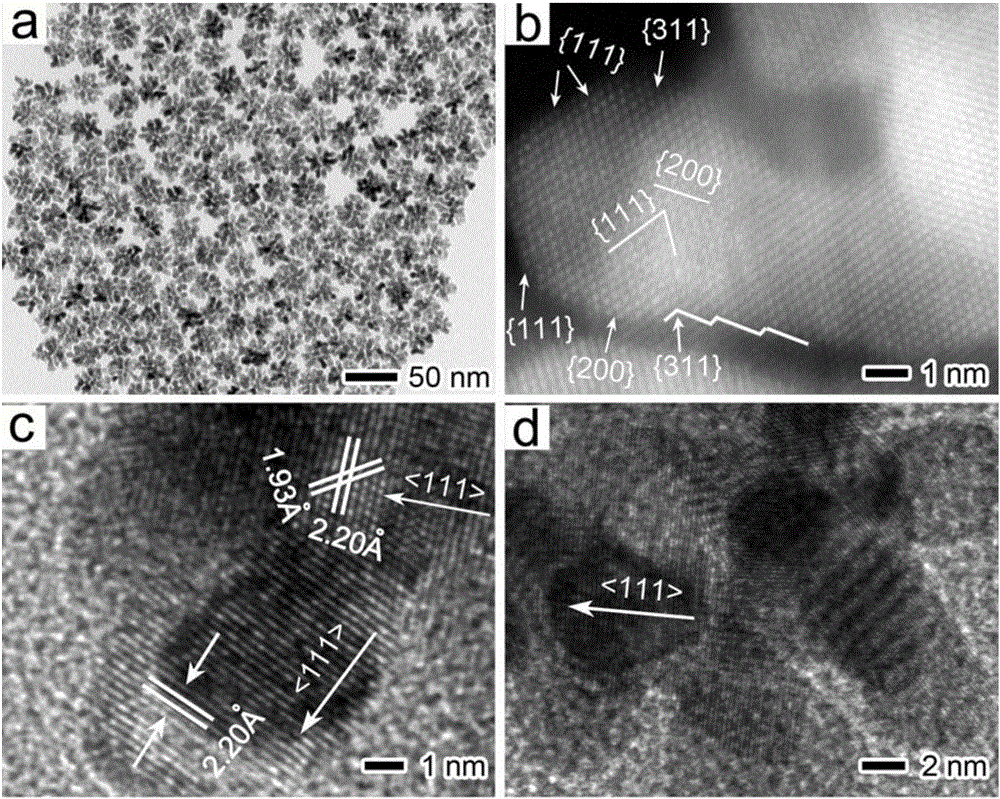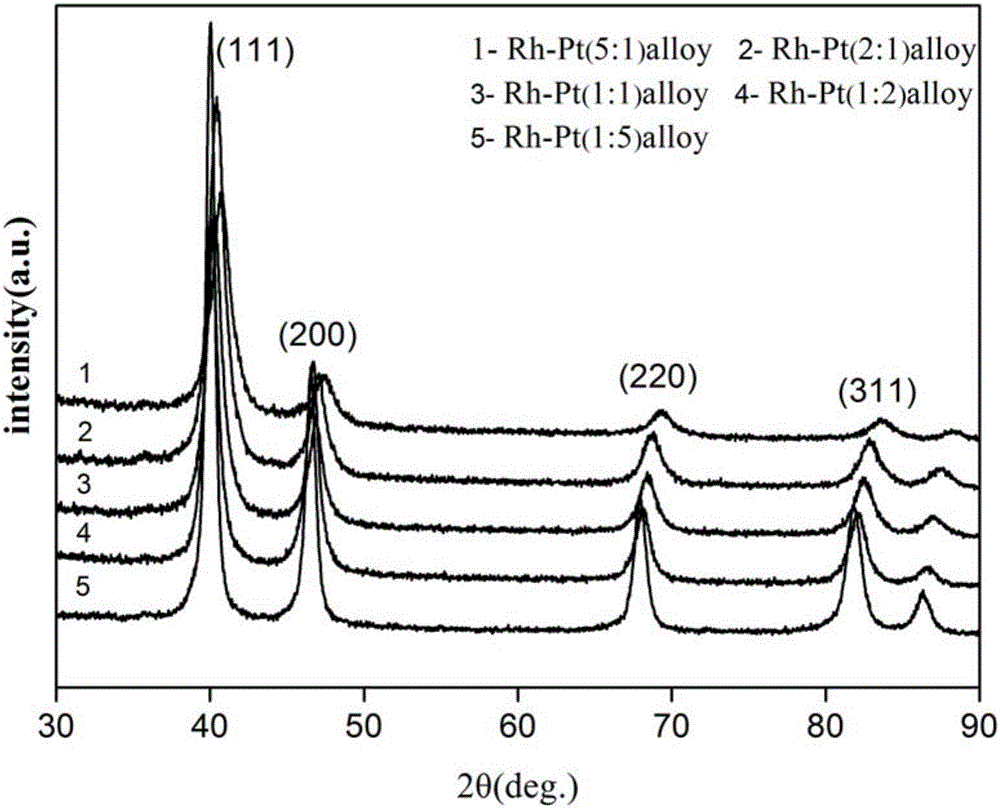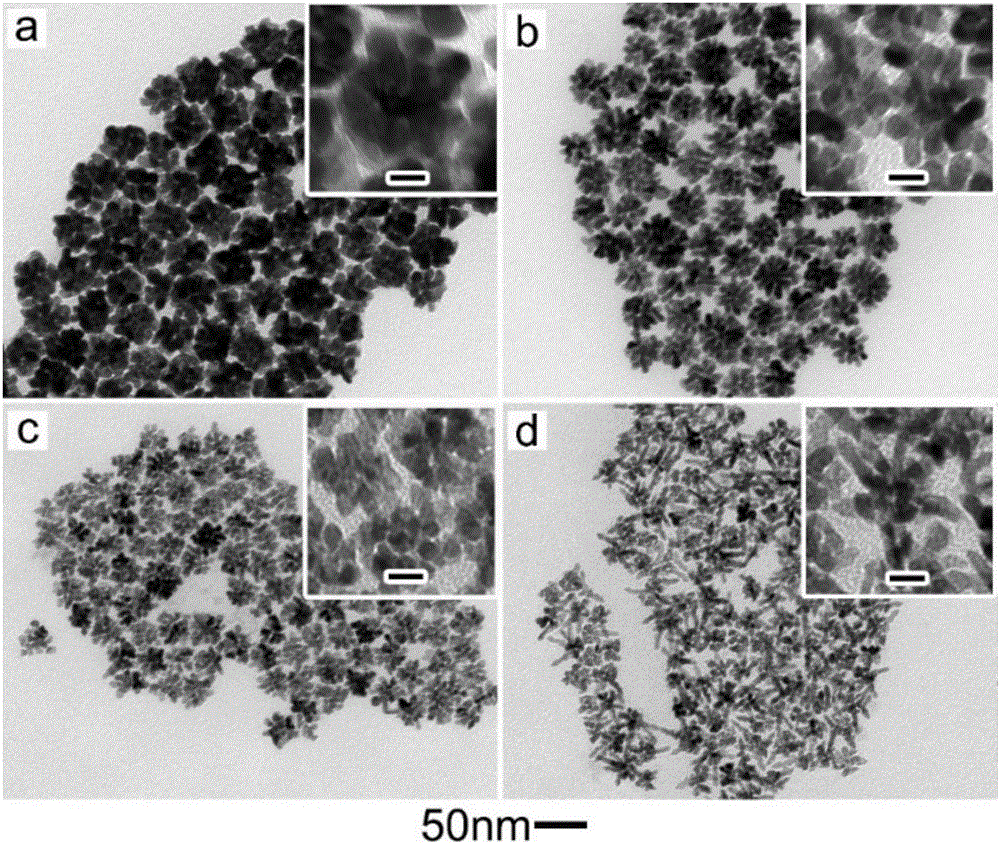Rhodium platinum alloy nanometer flower and preparation method thereof
A platinum alloy and nanoflower technology, applied in the field of nanomaterials, can solve the problems of complex preparation methods, low reaction repetition rate, poor dispersibility, etc., and achieve easy large-scale production, good size uniformity, and good chemical stability. Effect
- Summary
- Abstract
- Description
- Claims
- Application Information
AI Technical Summary
Problems solved by technology
Method used
Image
Examples
Embodiment 1
[0039] Firstly, 9.9mg rhodium trifluoroacetate and 11.8mg platinum acetylacetonate were stirred and dissolved in 3mL oleylamine at room temperature; then 300mg CTAB and 5mL oleylamine were mixed in a 20mL seed bottle; then the seed bottle was heated at 200°C After stirring for 10 minutes in a heating platform, 3 mL of oleylamine containing the precursor was injected, and the reaction was carried out at 200 °C for 2 h. After the reaction is over, the reaction solution is centrifuged to obtain rhodium-platinum alloy nanoflowers.
[0040] The TEM morphology of rhodium-platinum alloy nanoflowers is as follows: figure 1 As shown in (a), the size distribution of nanoflowers is uniform, the diameter is 20-45nm, the width of stamens is 2-9nm, and the length is 5-20nm; Figure (b) is a scanning transmission electron microscope for preparing rhodium-platinum nanoflowers in this embodiment ( STEM) figure, figure (c, d) prepares the high-resolution transmission electron microscope (HRTEM)...
Embodiment 2
[0042] Firstly, 3.3mg rhodium trifluoroacetate and 19.7mg platinum acetylacetonate were stirred and dissolved in 3mL oleylamine at room temperature; then 300mg CTAB and 5mL oleylamine were mixed in a 20mL seed bottle; then the seed bottle was heated at 200°C After stirring for 10 minutes in a heating platform, 3 mL of oleylamine containing the precursor was injected, and the reaction was carried out at 200 °C for 2 h. After the reaction is over, the reaction solution is centrifuged to obtain rhodium-platinum alloy nanoflowers, such as image 3 (a).
Embodiment 3
[0044] Firstly, 6.6mg rhodium trifluoroacetate and 15.7mg platinum acetylacetonate were stirred and dissolved in 3mL oleylamine at room temperature; then 300mg CTAB and 5mL oleylamine were mixed in a 20mL seed bottle; then the seed bottle was heated at 200°C After stirring for 10 minutes in a heating platform, 3 mL of oleylamine containing the precursor was injected, and the reaction was carried out at 200 °C for 2 h. After the reaction is over, the reaction solution is centrifuged to obtain rhodium-platinum alloy nanoflowers, such as image 3 (b).
PUM
| Property | Measurement | Unit |
|---|---|---|
| diameter | aaaaa | aaaaa |
Abstract
Description
Claims
Application Information
 Login to View More
Login to View More - R&D
- Intellectual Property
- Life Sciences
- Materials
- Tech Scout
- Unparalleled Data Quality
- Higher Quality Content
- 60% Fewer Hallucinations
Browse by: Latest US Patents, China's latest patents, Technical Efficacy Thesaurus, Application Domain, Technology Topic, Popular Technical Reports.
© 2025 PatSnap. All rights reserved.Legal|Privacy policy|Modern Slavery Act Transparency Statement|Sitemap|About US| Contact US: help@patsnap.com



